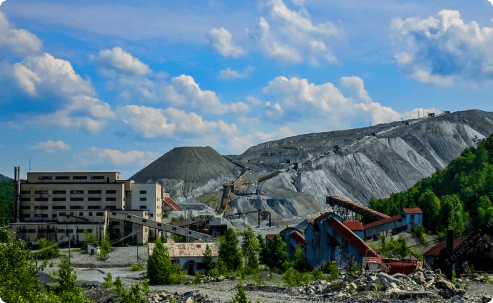Get Your Free Mesothelioma Guide

Find a Top Mesothelioma Doctor

Access Help Paying for Treatment

Certain states are known for high rates of asbestos exposure and asbestos-related deaths. Some heavily affected states, including Pennsylvania, California and Washington, have high rates of exposure. Asbestos-related deaths in those states extend into the thousands.

Every state is home to numerous job sites where asbestos was prevalent. The toxic mineral was widely used in industrial, commercial and domestic settings.
Mesothelioma incidence rates are higher in the northeast and northwest United States. Here, asbestos mining and processing were common throughout the 20th century. Mining towns such as Libby, Montana, and Ambler, Pennsylvania, continue to deal with the deadly legacy of the asbestos industry.
States in the West are also a hotbed for environmental asbestos exposure, with naturally occurring asbestos deposits in many mountainous regions of Montana, Washington, Idaho, Wyoming and California.
Other states synonymous with manufacturing and trade have high incidence rates of asbestos-related diseases. These states include New Jersey, Michigan and Texas. States with some of America’s largest shipyards saw high rates of asbestos exposure. Examples include California, New York and Louisiana.
Industries in every U.S. state have used asbestos in some capacity for decades. Some states mined the toxic mineral. Others processed the fibers or used them as a fireproofing additive to various products. Asbestos is regulated today but has yet to be entirely banned.
More information on asbestos exposure can be found in the following U.S. regions and their corresponding states:
Naturally occurring asbestos deposits are located across the U.S. Hilly, mountainous ranges can contain asbestos deposits. Any area with large concentrations of host rocks, such as serpentine, may be laced with asbestos.
Residents that live near deposits face an elevated risk of asbestos exposure. The danger is exceptionally great if the naturally occurring asbestos has been commercially mined.
According to the United States Geological Survey, 60 asbestos mines were once in operation throughout the eastern U.S. These mines varied in size and were active at different times.
The first asbestos mining operation began in 1894 in the Sall Mountain region of Georgia. The mines produced anthophyllite asbestos. This type is also mined in North Carolina, Virginia, Maryland, Connecticut and Massachusetts.
Amphibole asbestos was mined in Pennsylvania in the early 1900s. Chrysotile asbestos was mined on Belvidere Mountain in Vermont until 1993. This type has been the most frequent in commercial use.
Three chrysotile asbestos mines in Wyoming included the Fire King deposit, the Smith Creek deposit and the Casper Mountain deposit. This asbestos was used for chimney construction in 1920. It was shipped to flooring manufacturers in 1912.
Libby, Montana, was one of the most heavily asbestos-polluted cities in the nation. The town’s asbestos-contaminated vermiculite mine is the source of the pollution. The mine operated from 1919 to 1990.
More than 400 deaths in Libby are attributed to asbestos exposure. More than 1,750 town residents have been diagnosed with an asbestos-related diseases, including mesothelioma.
The EPA added Libby to its National Priorities List in 2002. This sparked a 20-year, $600 million cleanup. In 2009, the EPA declared the town a public health emergency.
By 2018, the EPA announced the completion of a 3,000-site cleanup effort. The effort included businesses, yards and parks throughout the area.
In 2021, it finished restoration efforts covering all roads and highways in and between Libby and nearby Troy.
Another Montana site includes the Karst mine in southern Montana. Here, small amounts of anthophyllite asbestos were extracted in 1923 and 1928. Further extraction occurred between 1933 and 1935. Asbestos from this mine was used to make wall and ceiling insulation, roofing compound and insulation at oil refineries.
The Rocky Mountains are home to several small asbestos deposits. Five areas were mined for asbestos. One site, the Kamiah anthophyllite deposit in Idaho, operated from 1909 to 1925. Asbestos from this mine was used to make pipe insulation, boiler covers, wall plaster and paint. It was also used as a binding agent in cement and asphalt.
Washington is home to dozens of asbestos deposits. A deposit of chrysotile in Sumas Mountain, located in Whatcom County, drains into the Sumas River. USGS tests from 2011 to 2013 revealed that chrysotile asbestos makes up 0.27% to 37% of the river’s sediment. The asbestos is so concentrated that the river runs white.
California has many naturally occurring sources of asbestos because serpentine rock, from which chrysotile originates, is common in the state.
Experts are watching El Dorado County in Northern California, a community built on a large asbestos deposit. Air samples from the EPA in 2004 raised concerns about exposure from stirred-up dirt in county parks.
Another site for concern in California is the Clear Creek Management Area. This site sits on one of the world’s largest naturally occurring asbestos deposits. This 31,000-acre serpentine deposit is frequently visited by thousands of off-road motorcyclists, hikers and campers each year.
The Clear Creek Management Area was once home to the Atlas Asbestos Mine. The mine is now a designated Superfund site by the EPA.
According to the USGS, the central part of the U.S. has fewer asbestos deposits than other regions. Although 26 natural asbestos occurrences are documented, only five sites in Missouri, Arkansas and Oklahoma were evaluated for mining or commercial production.
Get Your Free Mesothelioma Guide

Find a Top Mesothelioma Doctor

Access Help Paying for Treatment

Some states, such as Ohio, Indiana, Michigan, New Jersey, Illinois and West Virginia, are home to many industrial and manufacturing facilities that place many workers at risk of asbestos exposure.
Shipyards were also sources of frequent exposure. States featuring big shipyards include California, Washington, Texas, Louisiana, Virginia, Massachusetts and New York.
Refineries were another source of dangerous exposure. Many of them are located in Texas and Louisiana.
When people are exposed to asbestos in urban settings, state health officials call it environmental exposure. This kind of exposure can happen in public buildings and neighborhoods near facilities that processed or used asbestos.
In the mid-1980s, the U.S. Environmental Protection Agency estimated 20% of state and local public buildings in the U.S. contained friable asbestos materials.
Friable means the asbestos is damaged and may become easily airborne. In 1989, New York City estimated 68% of existing buildings contain asbestos and 81% of that was friable.
In 1984, the EPA performed an assessment of asbestos in public schools. They determined more than 8,500 schools contain friable asbestos. The agency estimated more than 3 million children were at risk of exposure at the time.
A 2015 report commissioned by Sens. Ed Markey (D-Mass.) and Barbara Boxer (D-Calif.) shows that more than two-thirds of local education agencies surveyed said their schools contain asbestos.
News reports of asbestos in schools reveal a nationwide problem. For example:
Elevated rates of asbestos-related diseases are widely documented in neighborhoods around facilities that processed asbestos ore or used asbestos in manufacturing.
The EPA identified 262 sites in 40 states that received shipments of asbestos-contaminated vermiculite ore from Libby, Montana. A number of these sites were exfoliation facilities, which posed a higher risk of environmental exposure than facilities that only stored ore. The exfoliation process expanded the vermiculite and caused asbestos fibers to become airborne.
Vermont received only two shipments (the fewest of all states). California and Texas received millions of tons of vermiculite. Some of the vermiculite was used to make Zonolite insulation. This insulation found its way into an estimated 35 million homes across the country.
The Agency for Toxic Substances and Disease Registry studied 70 of these sites in 23 states. The agency reported elevated rates of pleural and peritoneal mesothelioma around the neighborhoods of 17 sites.
This kind of exposure is far less common today than in the past. The primary source of this kind of exposure in the U.S. today is chloralkali plants.
However, there are communities such as Libby and Ambler, Pennsylvania, that continue to deal with illness. Environmental contamination is present long after mines and asbestos factories closed.
The chlor-alkali industry uses nearly all of the asbestos imported into the U.S. in recent years to manufacture chlorine, caustic soda and hydrogen. Asbestos is incorporated into filtration membranes in the production of these chemicals.
Safer options than asbestos membranes are available. Examples include perfluoroalkyl and polyfluoroalkyl substances. Many chloralkali plants in Europe have converted to safer methods to comply with asbestos bans in European countries.
The OxyChemo plant in Geismar, Louisiana, used asbestos diaphragms until 1993.
Recommended ReadingStay up-to-date on treatment, research, clinical trials, doctors and survivors
The information on this website is proprietary and protected. It is not a substitute for professional medical advice, diagnosis or treatment. Any unauthorized or illegal use, copying or dissemination will be prosecuted. Please read our privacy policy and terms of service for more information about our website.
This website and its content may be deemed attorney advertising. Prior results do not predict a similar outcome.
The Mesothelioma Center’s claim as the most trusted resource is based on our more than 150 5-star Google and BBB reviews. Our organization also helps more than half of all mesothelioma patients annually diagnosed.
Your web browser is no longer supported by Microsoft. Update your browser for more security, speed and compatibility.
If you are looking for mesothelioma support, please contact our Patient Advocates at (855) 404-4592
The Mesothelioma Center at Asbestos.com has provided patients and their loved ones the most updated and reliable information on mesothelioma and asbestos exposure since 2006.
Our team of Patient Advocates includes a medical doctor, a registered nurse, health services administrators, veterans, VA-accredited Claims Agents, an oncology patient navigator and hospice care expert. Their combined expertise means we help any mesothelioma patient or loved one through every step of their cancer journey.
More than 30 contributors, including mesothelioma doctors, survivors, health care professionals and other experts, have peer-reviewed our website and written unique research-driven articles to ensure you get the highest-quality medical and health information.
My family has only the highest compliment for the assistance and support that we received from The Mesothelioma Center. This is a staff of compassionate and knowledgeable individuals who respect what your family is experiencing and who go the extra mile to make an unfortunate diagnosis less stressful. Information and assistance were provided by The Mesothelioma Center at no cost to our family.LashawnMesothelioma patient’s daughter


Whitmer, M. (2025, November 12). Asbestos Exposure Risks by State. Asbestos.com. Retrieved January 6, 2026, from https://www.asbestos.com/states/
Whitmer, Michelle. "Asbestos Exposure Risks by State." Asbestos.com, 12 Nov 2025, https://www.asbestos.com/states/.
Whitmer, Michelle. "Asbestos Exposure Risks by State." Asbestos.com. Last modified November 12, 2025. https://www.asbestos.com/states/.
An occupational scientist or another expert who specializes in occupational hazards reviewed the content on this page to ensure it meets current scientific standards and accuracy.

Arti Shukla, Ph.D., is an internationally renowned asbestos researcher known for her achievements in identifying biomarkers that cause mesothelioma. She is the director of the Shukla Research Lab, as well as a professor of pathology at The University of Vermont Larner College of Medicine.
Our fact-checking process begins with a thorough review of all sources to ensure they are high quality. Then we cross-check the facts with original medical or scientific reports published by those sources, or we validate the facts with reputable news organizations, medical and scientific experts and other health experts. Each page includes all sources for full transparency.
Please read our editorial guidelines to learn more about our content creation and review process.
